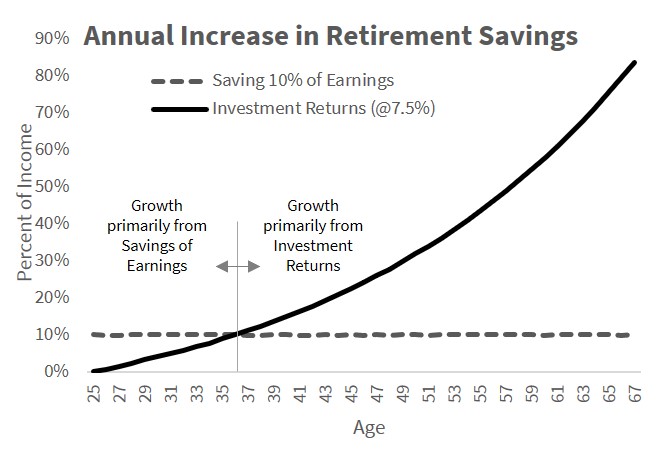At age 50, individuals stand at a significant crossroads in their financial journey, with many starting to actively consider retirement.
Assessing your wealth at age 50 is critical for securing a comfortable future. Let’s embark on this exploration of financial fortitude, guided by the wisdom of a couple of expert sources and some thoughts from Wealth45.
Assessing Your Wealth at Age 50
After decades of diligent financial stewardship, it’s time to take stock of your progress. While each financial odyssey is unique, benchmarks provide valuable signposts along the way.
The burning question: How much should you have amassed by age 50?
In an ideal world, this query finds resolution within a comprehensive financial blueprint. Yet, let’s be honest, who has the time for such meticulous planning?
Fear not, for we’re here to distill the wisdom of the ages into actionable insights, sans the complexity.
We also explore why the conventional wisdom / expert guidance on wealth accumulation doesn’t always make sense.
And, why the power of compounding investment returns is your best friend when saving for retirement.
Deciphering the Numbers
Enter the pundits from CNBC.com, citing wisdom from Fidelity Investments. According to their gospel, a nest egg equivalent to 6 times your income should be your aim by age 50.
But wait, where did that number come from?
For the pragmatic souls among us, let’s break it down:
According to Fidelity Investments—you need to have savings equal to 10 times your income if you want to retire at age 67. Age 67 is when individuals under 60 today will be eligible for full social security benefits.
Save more if you want to retire earlier and less if you can keep working until you are 70.
They breakdown the savings target by age to reach 10 times your income:
- Age 30 = 1x income
- Age 40 = 3x income
- Age 50 = 6x income
- Age 60 = 8x income
- Age 67 = 10x income
Hence, at 50-years-old you should have savings of around 6x your income according to Fidelity Investments.
Unveiling the Millionaire Next Door
Venture into the realm of Thomas Stanley and William Danko’s, “The Millionaire Next Door.” Here, a simple formula unveils the realm of the “average accumulator of wealth” (AAW).
For instance, if you’re cruising at 50 with a household income of $100,000, your savings odometer should read $500,000 (that’s 5 times your income).
Their formula for an AAW is:
“expected” net worth = (income X age) / 10
For example, if you are 50 years old and your household income is $100,000, you should have saved $500,000 (= $100,000 x 50 / 10). Or 5.0 times your income.
A dichotomy emerges between Fidelity’s decree and the Millionaire Next Door’s gospel, illuminating the diversity of paths to financial nirvana.
In general, the AAW target is higher than other “experts” when you are young but suggest a lower total target when you are older.
Navigating the Reality Matrix
Alas, the linear trajectories prescribed by the experts fail to capture the essence of wealth’s ascent. Enter compound interest, the unsung hero of financial alchemy.
If one saves a constant percentage of their income, and their income grows steadily, the growth trajectory of their net worth is not linear. This would be the case, for example, with regular contributions to a 401k plan.
Fidelity’s guidelines propose you should triple retirement savings during your 30s and double it during your 40s.
But Fidelity only targets growing retirement savings by 33% during your 50s (from 6x to 8x) and 25% during your 60s. Does this arithmetic hold water?
If you have managed to accumulate 6x your income by age 50, investment returns alone over the next decade should easily grow your savings by over 33%.
Even if you assume only a 5% annual return (which is well below historical norms for a diversified portfolio), your portfolio should grow by 63% in 10 years (pre-tax).
Your Retirement Roadmap – Wealth at Age 50
Since savings targets are a multiple of income, you also need to account for your income increasing over time.
So, the comparison is not as simple as shown above.
If your income grows by 3% per year, your income would be 34% higher after a decade. For example, household income of $100,000, after 10 years, would have grown to $134,000 per year.
Following Fidelity’s guidelines, you should target $600,000 in retirement savings (6x your $100,000 household income) at age 50.
And at age 60 you should target $1,070,000 (8x your $134,000 in household income after 10 years).
Hence, the actual increase in savings over the decade needs to be 78%. Not the 33% previously reference.
Regardless, growing your savings by 78% over a decade is far easier when your investment portfolio is providing most of the heavy lifting.
Contrast this with trying to (3x) triple your retirement savings during your 30s when you have very little savings to begin with. In that age, most of the increase in savings needs to come from socking away more money from earnings.
The Wealth45 Approach
We believe a better approach is to embrace compounding investment returns and build a plan based on saving a fixed percentage of your earnings every year.
We believe this provides a more rational approach to retirement savings and achieving the target wealth at age 50.
If you save 10% of your income every year, the growth from investment returns quickly eclipses the growth from new savings. Making it easier to grow your retirement nest egg the older you get.
 (graph based on assumptions outlined below for the Wealth45 guidelines)
(graph based on assumptions outlined below for the Wealth45 guidelines)
In addition, we believe you should target more like 12x your income at retirement (see Roadmap to Retirement: FIRE or FRA for details).
Although 10x is a reasonable retirement goal at age 67, your target should provide a cushion. Give yourself wiggle room for unforeseen circumstance.
Unfortunately, many people are forced to retire earlier than planned due to health issues, layoffs, or other uncontrollable events.
The Wealth45 breakdown of savings by age to reach 12 times your income:
- Age 30 = <1x income
- Age 35 = 1 to 2x income
- Age 40 = 2 to 3x income
- Age 45 = 3 to 4x income
- Age 50 = 4 to 5x income
- Age 55 = 6 to 7x income
- Age 60 = 8 to 9x income
- Age 65 = 10 to 11x income
- Age 67 = >12x income
Our guidelines are based on the following assumptions:
- Start saving for retirement at age 25
- Target retirement at age 67 (Full Retirement Age of those born after 1959)
- Household income grows at a steady rate throughout career (e.g., 3% annually)
- Constant savings rate (as % of income) throughout career (e.g., 10% including 401k match)
- Investment returns of 7.5% annually
Wealth45 vs “Expert” Guidance
Although our savings targets by age are not wildly different from the “experts,” there are a few important differences.
At age 50, we believe an appropriate target is slightly lower than either Fidelity or The Millionaire Next Door (TMND).
| Multiple of Income | Wealth45 | Fidelity | TMND (AAW) |
| Age 50 | 4.5x | 6x | 5x |
In general, the Wealth45 savings targets are lower when you are young and have just started to save for retirement.
But our targets accelerate faster when you are older and have accumulated a comfortable nest egg (and the return on your investments becomes the primary growth engine).
The crossover point is somewhere in your mid to late 50s where Fidelity and Wealth45 agree on the target. Before this age, Fidelity is recommending a higher savings as a multiple of income. Afterward, Wealth45 believes you should target a slightly higher multiple of income.
Reality Disconnect
All that being said, unfortunately, for most people these savings targets are completely unrealistic.
The majority of people in the United States have nowhere near this level of savings.
Data from the latest Federal Reserve Survey of Consumer Finances (2022):
| Age of head | Median Net Worth (‘000) | Median Income (‘000) |
| 35-44 | $136 | $86 |
| 45-54 | $247 | $92 |
| 55-64 | $365 | $82 |
Using the data above to calculate the net worth as a multiple of income:
| Age of head | Multiple of Income |
| 35-44 | 1.6x |
| 45-54 | 2.7x |
| 55-64 | 4.5x |
Clearly these savings multiples for median households are far below the targets proposed. And even these figures are too optimistic since median net worth is not the same as retirement savings.
For many people, the largest asset is their primary residence (i.e., the equity in their home). Although some people can downsize at retirement and live off the proceeds, this is easier said than done.
How to Set Yourself Up for Success
If you are fortunate enough to be able to save for retirement, there is a formula for long-term success.
- Start young – the earlier you can start socking away money for investing, the easier it is to reach your retirement goals
- Save a fixed percentage of your income every year – target 10%
- Invest your savings in a diversified portfolio aligned with your risk tolerance and time horizon
A simple way to implement this formula is to take advantage of your employer’s 401k plan (if you work for a company like Microsoft, Amazon, Google and most other large employers that provide matching contributions).
The company match will reduce the amount of money you need to save and help grow your retirement savings faster.
- Microsoft chips in (i.e., matches) 50 cent for every dollar you contribute (up to the max IRS limits). Hence, if you contribute 7% of your income, Microsoft will provide an additional 3.5%, putting your total savings at 10.5% annually.
- Amazon.com matches 50% on the first 4% of your contributions (for a total of 2%). Hence, you will need to contribute 8% of your salary to reach the 10% goal once Amazon chips in their 2%.
- Google will also match 50% on the dollar, with the added advantage of a 100% match on the first $3,000 in contributions. Hence, depending on your salary, you will need to contribute between 5% and 7% to reach the desired 10% overall savings rate.


